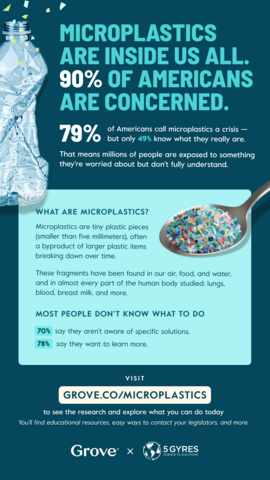Grove Collaborative Announces U.S. Microplastics Survey Results
New research with 5 Gyres shows overwhelming public concern on microplastics, with 79% of Americans declaring it a human and environmental health crisis
This press release features multimedia. View the full release here: https://www.businesswire.com/news/home/20250722455914/en/

Key Research Takeaways
The survey results released during
-
Awareness:
- 77% of Americans have heard the term microplastics, but only 49% of all Americans surveyed claimed to be very or somewhat familiar with microplastics— meaning 51% are not sure of what they really are.
- The research also found that Americans who are very or somewhat familiar with microplastics were 2.36x more likely to be aware of where microplastics come from.
- Awareness of the origins of microplastics is critical to conscious consumption and behavior change.
-
Concern
:
- Americans are most concerned about microplastics’ impact on our health (90%), links to serious health conditions (89%), and their presence inside the human body (90%), the general environment (89%), wildlife (89%), and our oceans (87%).
- Consumer alarm over the consequences of the plastic — and resulting microplastics — crisis cuts across all demographics, including political affiliations.
-
Information
:
- 78% of Americans are eager to learn how to limit microplastics exposure and reduce plastic consumption, but 70% say they are unaware of how to do either.
- 58% of Americans are eager for transparent labeling on products that contain microplastics, 49% want recommendations about the best brands, materials, or products that use less plastic or contain no microplastics, and 41% are interested in learning how their individual actions can reduce their potential exposure or impact.
- Information and education give consumers the necessary tools to take action, and consumers are craving more information.
-
Action
:
- Americans are overwhelmingly looking to the private sector to address microplastics (82%), but only 54% of respondents trust that companies are actively trying to reduce microplastics today.
- They support companies prohibiting microbeads from consumer products (86%), creating more air and water filter options to capture plastic microfibers (85%), adopting compostable materials over plastic (87%), and prioritizing refillable or reusable products instead of single-use (86%).
- Americans also support government action, with 71% support the banning of single-use plastics.
- There is a clear opportunity to build trust with consumers and constituents through meaningful action
Defining the Microplastics Crisis
Microplastics — small plastic pieces less than five millimeters long — are either intentionally produced or are a byproduct of larger plastic items that have broken down over time. These small particles can be inhaled2, ingested through food or water3, or directly absorbed by your skin — the body’s largest organ — due to the chemical additives in plastics leaching their way into our bloodstream through sweat and skin4.
The scientific consensus? Plastic poses a threat to our health, with micro- and nano-plastics having been found in the human body, including breastmilk5, placentas6, blood7, semen8, brains9 and virtually everywhere else in our bodies.10 The presence of plastics inside the human body can be troubling because, unlike other pollutants, plastics can contain 10,000 different chemicals, many of which are linked to diseases like diabetes and cancer.11 Each week, more and more research is confirming that microplastics are severely impacting our personal health and the environment.
The Call to Action for Business
While the plastic crisis is often framed as an environmental crisis, this research demonstrates that the average American views plastics and microplastics through a deeply personal and emotional lens, driven by concerns about their own health. As awareness of the problem grows, so does the demand for solutions. The call to action for business is clear: brands and corporations must reduce their use of and reliance on plastic and push their industries to meet the expectations of increasingly informed and concerned consumers.
“Microplastics are not just an environmental issue — they’re a public health crisis hiding in plain sight,” said
Brands and corporations created the microplastics crisis that society now grapples with, and the responsibility to solve it lies squarely with the private sector — instead of passing the buck to consumers by encouraging them to recycle their way out. This empty promise, pushed for decades by petrochemical companies, has fueled the mass consumption of plastics and led to an environmental and human health emergency. The evidence is clear: only 5% of plastic is actually recycled, while the remaining 95% ends up in landfills, incinerators, or the environment, ultimately accumulating in nearly every living organism on Earth.
“These findings are a wake-up call for business leaders and policymakers,” said
What Consumers Can Do Today
Current research underscores that microplastics impact virtually all life on the planet, with no silver bullets to solve this growing human and environmental crisis. However, reducing plastic consumption and microplastics exposure are the first step to protecting yourself, your home, and the planet.
Grove and 5 Gyres are calling consumers to educate themselves and join the fight. Visit Grove.co/MICROPLASTICS to:
-
Learn More
The more consumers know about microplastics, the more empowered they are to change behaviors. Grove has consolidated trusted resources to help you understand what microplastics are and how to reduce your exposure — starting today. -
Advocate
Legislation and regulation are urgently needed to protect all Americans from the harm caused by microplastics. Join Grove in supporting 5 Gyres’ #MicroplasticFreeUS campaign by contacting your elected officials. -
Go Beyond Plastic™
One of the most impactful ways to reduce microplastics exposure is by limiting the amount of plastic you bring into your home. Look for sustainable swaps and choose more circular, low-waste materials when possible.
To read the full research report and methodology, visit www.5gyres.org/MicroplasticFreeUS.
|
|
1
https://www.5gyres.org/s/Microplastics-Polling-Report.pdf;
2 https://www.ciel.org/breathing-plastic-the-health-impacts-of-invisible-plastics-in-the-air/
3 https://www.pbs.org/newshour/show/why-you-may-be-eating-and-drinking-more-microplastics-than-you-thought
4 https://www.fastcompany.com/91110811/microplastics-toxic-chemicals-absorb-into-skin
5 https://pmc.ncbi.nlm.nih.gov/articles/PMC9269371/
6 https://pubmed.ncbi.nlm.nih.gov/33395930/
7 https://pubmed.ncbi.nlm.nih.gov/35367073/
8 https://pubmed.ncbi.nlm.nih.gov/36948312/
9 https://www.cnn.com/2024/08/23/health/plastics-in-brain-wellness/index.html
10 https://magazine.hms.harvard.edu/articles/microplastics-everywhere
11 https://www.5gyres.org/newsroom/how-microplastics-corrupted-our-planet
About The 5
The 5
About
View source version on businesswire.com: https://www.businesswire.com/news/home/20250722455914/en/
Media Relations Contact
Ryan.Zimmerman@grove.co
Source:
